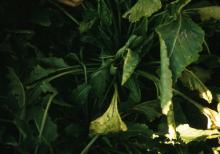Cause Beet curly top virus is spread in North American only by the beet leafhopper (Circulifer tenellus). The virus has an extensive host range. The leafhopper breeds readily on mustards and overwinters in perennial or winter annual weed hosts, carrying the virus to beets and other crops in spring.
Symptoms Young leaves roll in, pucker, develop blister-like thickenings, and are dwarfed. Vein clearing appears in young leaves followed by vein swellings on the lower sides, which appear knotted or gall-like. Roots are dwarfed, and rootlets may be twisted and distorted. Tap roots are covered with many rootlets ("hairy root"). Young plants die quickly.
Cultural control
- Early seeding is advised.
- Sow seed thickly to escape the disease.
- Rogue infected plants.


